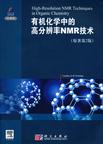有机化学中的高分辨率NMR技术
出版时间:2010-9 出版社:科学出版社 作者:克拉里奇 编 页数:383
Tag标签:无
前言
本书自第1版出版至今已经9年了。在这9年里,核磁共振谱学学科不断地发展新的方法,改进了仪器,拓展了应用范围。第2版旨在反映出这些领域里有关小分子和中等分子结构鉴定的一些较为关键的进展。其中包括新的和增强的脉冲序列(许多都是在第1版基础上),一些能给化学家提供新的信息或高质量的数据。这包括许核磁仪软件的新进展,正是由于这些软件才使得仪器的敏感程度大大提高,应用范围也因而被拓宽。增加的许多内容反映在脉冲方法上,在许多章节中都可以看出来。较充实地增补的一些内容简要列举如下。第1章和第2章介绍了核磁共振谱学和脉冲方法背景,这些在后面的章节中也会看到,因而改动较小。正如第1版一样,第2版也没有尝试引入核磁共振光谱学的基本参数,也没有介绍这些参数与化学结构的关系,这些主题在许多其他章节也有描述。第3章提供了核磁共振光谱学的实际应用方面的信息,也提供了如何充分利用好仪器的相关信息,而且该章增加了一些反映重要硬件的发展的内容。尤其是目前的探头技术,包括低温、微尺度、流量探头。事实上,也包含了这些概念的组合,并且对仪器校准的最新方法也进行了说明。第4章阐述了一维方法,并且增补了一些在频谱编辑方法方面的新进展,以及使用外部参比的核磁共振光谱的定量方法。第5章介绍了二维核磁以及同核相关的方法,涉及能改进谱图质量的方法进展,如零量子干扰抑制。在确定碳碳相关方法的部分也有所拓展,特别是得益于质子检测的部分。一旦仪器的灵敏度提高,其应用范围就会拓宽。第6章介绍了异核相关技术,主要增加了确定分子内远程氢碳相关的方法进展上,也即是使用了一种更灵活的方法来确认分子的连接方式。包含了提高过滤单键信号的新方法,提高样品远程碳氢耦合常数以克服谱图拥挤的方法,并且提供了从三键中区分双键相关的方法。还简要介绍了异核耦合常数自身变化的测定。介绍了采用两个异核之间的相关(即X_Y相关谱,X和Y均不是质子)的三重共振方法。所涉及的内容还包括最新利用质子探测的新方法。第7章介绍了J一解析方法,在同核方法的吸收模式变化中仅给出一个信号,在多重峰的质子谱中,对“质子去耦质子谱”的产生有潜在应用性。
内容概要
本书旨在反映核磁共振领域有关小分子和中等分子结构鉴定的一些较为关键的进展。 第1~2章介绍了核磁共振谱学和脉冲方法背景。第3章提供了核磁共振谱学的实际应用,如低温、流量探头等。第4章阐述了一维方法,以及使用外部参比的核磁共振光谱的定量方法。第5章介绍了二维核磁以及同核相关的方法。如零量子干扰抑制。第6章介绍了异核相关技术以及异核耦合常数自身变化的测定等内容。第7~8章分别介绍了J-解析方法与NOE效应。第9章主要阐述了弥散核磁共振谱和二维弥散序列核磁共振谱(DOSY)。第10章描述了现代核磁共振实验,如绝热频率扫描再脉冲和去耦方面的应用等内容。
作者简介
编者:(英国)克拉里奇(Timothy D W Claridge)
书籍目录
第2版前言第1版前言第1章 绪论 1.1 高分辨率NMR的发展 1.2 现代高分辨率NMR和本书 1.2.1 本书包含的内容 1.2.2 脉冲序列命名法 1.3 现代NMR技术的应用 参考文献第2章 高分辨率NMR的介绍第3章 高分辨率NMR的实用性第4章 一维技术第5章 通过化学键I的相关性:同核位移相关第6章 通过化学键II的相关性:异核位移的相关性第7章 裂分位移和耦合:J-解析谱第8章 通过空间的相关:核间奥氏效应第9章 核磁谱的漫射第10章 实验方法附录:缩写术语表索引
章节摘录
插图:From the initial observation of proton magnetic resonance in water and in paraffin, thediscipline of nuclear magnetic resonance (NMR) has seen unparalleled growth as an analyticalmethod and now, in numerous different guises, finds application in chemistry, biology,medicine, materials science and geology. Despite its inception in the laboratories of physicists,it is in the chemical laboratory that NMR spectroscopy has found the greatest use and, it may beargued, has provided the foundations on which modern organic chemistry has developed.Modern NMR is now a highly developed, yet still evolving, subject" that all organic chemistsneed to understand, and appreciate the potential of, if they are to be effective in and able toprogress their current research. An ability to keep abreast of developments in NMR techniquesis, however, a daunting task, made difficult not only by the sheer number of available techniquesbut also by the way in which these new methods first appear. These are spread across thechemical literature in both specialised magnetic resonance journals and those dedicated tospecific areas of chemistry, as well as the more general entities. They are often referred to byesoteric acronyms and described in a seemingly complex mathematical language that does littleto endear them to the research chemist. The myriad of sequences can be wholly bewildering forthe uninitiated and can leave one wondering where to start and which technique to select for theproblem at hand. In this book I have attempted to gather together the most valuable techniquesfor the research chemist and to describe the operation of these using pictorial models. Even thislevel of understanding is perhaps more than some chemists may consider necessary, but onlyfrom this can one fully appreciate the capabilities and (of equal if not greater importance) thelimitations of these techniques. Throughout, the emphasis is on the more recently developedmethods that have, or undoubtedly will, establish themselves as the principal techniques for theelucidation and investigation of chemical structures in solution. NMR spectroscopy is, above all, a practical subject that is most rewarding when one has aninteresting sample to investigate, a spectrometer at one's disposal and the knowledge to make themost of this (sometimes alarmingly!) expensive instrumentation. As such, this book contains aconsiderable amount of information and guidance on how one implements and executes thetechniques that are described and thus should be equally at home in the NMR laboratory as at thechemist's or spectroscopist's desk.
编辑推荐
《有机化学中的高分辨率NMR技术(原著第2版·导读版)(英文版)》:主要特色:起点高、理论性强,深入阐述高分辨率NMR中的新方法和新技术。精选大量二维NMR谱图,详述核磁共振二维谱的内容。深入探讨了NOE效应、异核、同核、间接同核的J-解析谱等内容。适合核磁仪实验室及化学、医学等相关专业需掌握NMR技术的人员阅读。
图书封面
图书标签Tags
无
评论、评分、阅读与下载
用户评论 (总计3条)
- 书真的很不错,便宜。
- 书看起来不错,英文的,水平低的看起来有点困难!!
- 这书非常好,经典,如果是翻译本就更好了
